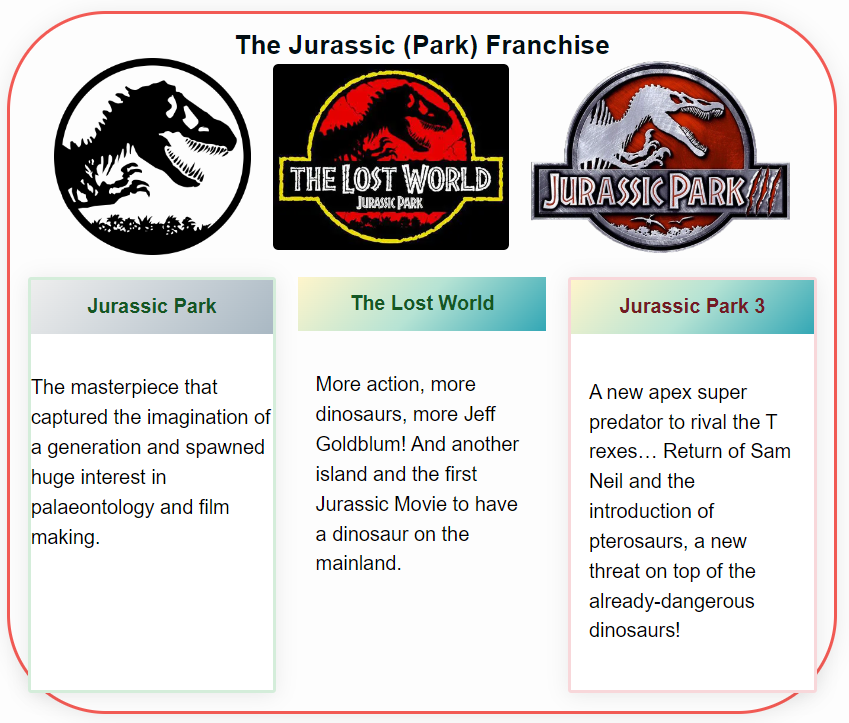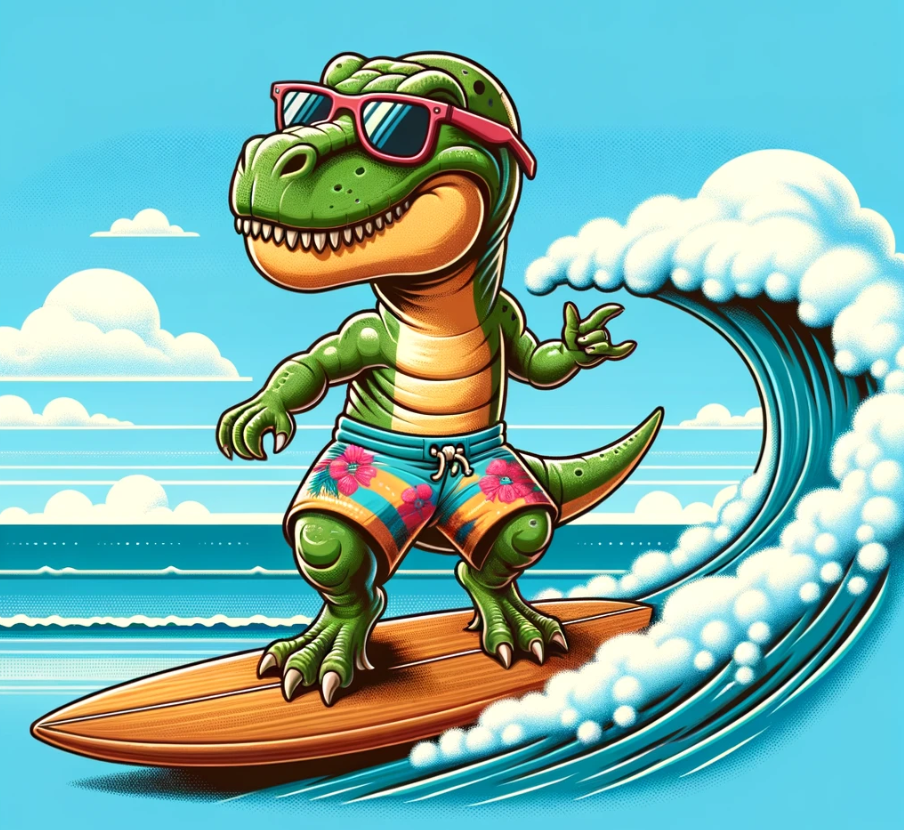Have you ever wondered about all the dinosaurs that roamed the lands of Isla Nublar? A dinosaur-packed rollercoaster ride, Jurassic Park is set on a prehistoric themed island inhabited by creatures revived from fossilised DNA. Ever since I was a kid, first in 1993, I was obsessed about how the dinosaurs would free roam around the abandoned park and fill out the island, especially as it was revealed some of the species were already breeding…
Of course, the sequels and other media expand the Jurassic universe to encompass all kinds of prehistoric, no-longer extinct creatures inhabiting not only more islands but by the time we get to the sixth movie, dinosaurs are living all over the world, coexisting with modern life and us humans!
Here you’ll find a comprehensive rundown of every single dinosaur featured across the entire franchise, helping fans and dino-lovers get intimately acquainted with these awe-inspiring beasts. We’ve managed to keep track of all the dinosaurs from the few species starting life on Isla Nublar (the first island) to even more dinosaurs, pterosaurs and marine reptiles all the way to Europe and beyond…
Let’s embark on this journey – after all, there are no park fences to hold us back here!
The dinosaurs in Jurassic Park are known for their on-screen portrayals and the scientific accuracy of their depictions. It’s worth remembering, especially with the original Jurassic Park, that they were scientifically accurate for their time. Even in the last ten years, we’ve made new discoveries and there have been plenty of updated theories and changes to our perception of these amazing animals.
On-screen portrayals
I was seven or eight years old when I watched Jurassic Park in 1993 at the cinema, and it’s one of the earliest memories I have of cinema and movies in general.
I didn’t feel like I was watching a kid-friendly film, despite it being Stephen Spielberg and starring kids as a couple of the main protagonists.
I also didn’t feel like I was watching a trashy monster movie, this film had grown ups debating around a dinner table and there was no “bad guy” or villain, as such! You could say Nedry fit this but he was more of greedy fool enabling the breakouts than an actual villain.
My main takeaway from watching Jurassic Park as a child was that these were living, breathing animals that existed on our planet before we turned up.
Then there was the science fiction aspect, the ethics and the overall fantasy of cloning spectacular dinosaur species for a theme park of all things.
They looked real and scary. This made me think about how they lived many millions of years ago. The first dinosaur we see properly is a Brachiosaurus.
It was huge! But most impressive was how it looked and moved, interacting with the landscape, with the people stood in awe watching it. It looked immersive and awesome and I was hooked on this alone, even without the horror element we see at the very beginning.
The Tyrannosaurus Rex is the most famous one in the movie. Its roar was made by mixing sounds from different animals. People loved it so much that Jurassic Park became the top-earning movie when it came out, making $913 million all over the world! Making these dinosaurs seem alive for close-ups was quite hard though – but well worth it!
Scientific accuracy
Jurassic Park used the best science of its time. Many dinosaurs in the film look like what experts thought they would back then. For example, Velociraptors are shown with no feathers.
Now we know that’s not right. They had feathers!
The T Rex is another case. It stands tall and roars a lot in the movie. Yet, real T Rexes might have hunted closer to the ground and made softer sounds.
Premise
Jurassic Park is set on a big island. This island is not like any other, it’s a theme park filled with real dinosaurs! Scientists use the DNA from old times to make these great beasts.
They pick only the best people to see the park first. These folks think they are safe, but they soon find out that’s not true at all. The dinosaurs do not stay quiet and calm as they hoped, causing a lot of trouble.
Dinosaurs in the Original Trilogy
Let’s get to what you came here for, all the dinosaurs listed in each Jurassic movie!
Dinosaurs in Jurassic Park

65 million years in the making…
1. Velociraptor
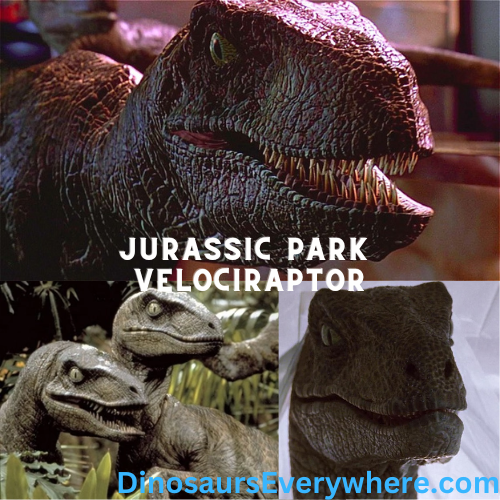
The Velociraptor was one of the iconic dinosaurs in the original Jurassic Park trilogy, known for its intelligence and lethal hunting abilities.
The Velociraptor is a small dinosaur in Jurassic Park. It looks like a bird and moves very fast. This dinosaur has sharp claws and teeth. In the movie, it shows us how smart these dinosaurs are.
They can open doors and work together to hunt their food. Some people think they were as clever as a big cat or bird in real life too! These dinosaurs lived about 70 million years ago but in Jurassic Park, we get to see them up close!
Did You Know?
The real life Velociraptor was a fair bit smaller than its depiction in the Jurassic movies. During filming of Jurassic Park there was discussion about the featured dinosaurs being based more on Deinonychus, but even this wasn’t quite right.
But then the Utahraptor was discovered around this time and it kept the raptor species shown more or less accurate against a kind of raptor species, at least.
Deinonychus is a bit of a mouthful for non-dinosaur types and Utahraptor doesn’t have quite the same feel to it as Velociraptor!
What I found so menacing about the Jurassic Park Velociraptors was the fact that they were around the size of a human and intelligent enough to solve problems, especially when it came to finding food.
And then further into the film, they learned to open doors – ramping up the threat to the survivors when they were “safely” back inside the Visitors Center.
These things not only had teeth and claws everywhere, but they could leap, ambush and quietly solve problems – and get anywhere they wanted once the fences were down!
The film also showed how dinosaurs would hunt in packs, since Velociraptors were small when compared to even medium sized prey species, they could overpower herbivores much larger than themselves, even dinosaurs that would usually present a threat from sheer size or other defenses.
A key feature of Velociraptor was the sickle claw on their hind legs, which you can see close up in the infamous raptor kitchen scene and Dr Alan Grant has one as a keepsake – at least until he drops it when hanging out in a tree with the kids.
2. Brachiosaurus

Brachiosaurus is the first dinosaur seen on-screen in Jurassic Park. This huge creature makes a big splash in their film debut. They are tall, with long necks and front legs that are longer than their back legs.
The Brachiosaurus is a calm, plant-eating dinosaur. It used its height to eat leaves off trees that other dinosaurs could not reach. Despite their massive size, they seem friendly towards humans in the movie.
After we see the cunning and brute force of a single Velociraptor (not that we know exactly what it is at this point), we move on to John Hammond trying to convince the invited experts to endorse his resort by inviting them to the island.
And what better specimen than an instantly recognisable “dinosaur” than a fully grown sauropod just walking around grazing on the tallest of the trees?
This really framed Jurassic Park as a place of wonder and inserting such a majestic animal from another time into a modern landscape, combined with the reactions superbly played out by Laura Dern and Sam Neil really sold it to me as a kid, that this thing looked real.
3. Parasaurolophus
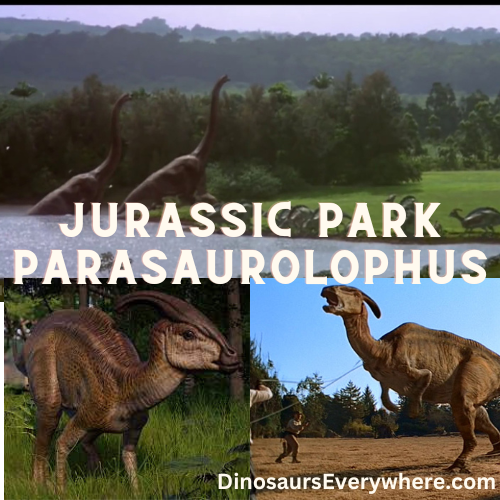
Parasaurolophus is a sight to see in Jurassic Park. Its long crest sets it apart. The crest works like a trumpet, making loud sounds. People first see this dinosaur in the “Jurassic Park” sequel, “The Lost World”.
This plant-eating dino moves in herds and likes calm lakes. It can walk on both two legs and four legs. Parasaurolophus brings joy to the park with its unique looks and sounds.
Blink and you’ll miss it, the Parasaurolophus could be seen in the background when the guests see their first dinosaur, the Brachiosaurus. When they look over at the lake, you can see a mixed herd of Brachiosaurus and Parasaurolophus in and around the water.
This quick glimpse by Dr Alan Grant confirms many years of speculation – they do move in herds!
4. Dilophosaurus
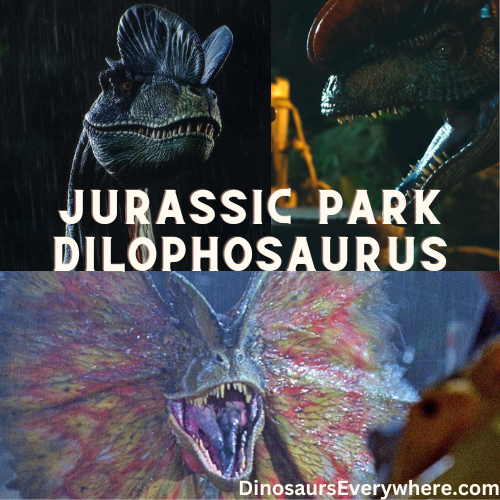
Dilophosaurus shows up in Jurassic Park as a small dinosaur. It is well known for its scary look and two fine crests on its head. This dinosaur can spit poison to blind and paralyse its prey.
It looks friendly at first, but then it scares us all! In real life, there are no signs that this creature could spit poison or had a big frill around its neck. But these cool features make Dilophosaurus one of the best dinosaurs in the Jurassic Park movie list.
Be careful when you see this one!
Did You Know?
The real life Dilophosaurus had the two crests on the head but no frill or venom sacks. It was also 12 feet tall, much bigger than the one in Jurassic Park but the one seen could have been a juvenile…
One of the most iconic dinosaur species in Jurassic Park, this medium sized carnivore has some of the most stunning – and fictional – features.
Whether you go with the head canon that this species was one of Dr Henry Wu’s hybrids, or he accidentally got these traits from splicing other genes to fill the gaps, or you suspend your disbelief enough to go with this dinosaur was actually like this in real life, it’s still an amazing addition to Jurassic Park that makes you wonder what features other dinosaurs had that we couldn’t possibly imagine…
Chances are that the film creators added the frill and ability to spit venom to spice things up, otherwise all three carnivores would have been just teeth and claws of various sizes.
5. Triceratops

The Triceratops is one of the well-known dinosaurs featured in Jurassic Park. It was a herbivorous dinosaur that lived during the late Cretaceous period. The Triceratops is best known for its three large horns on its head and a frill at the back.
These features were used for defense against predators and also for mating displays. Unlike other dinosaurs, the Triceratops had a beak-like mouth with rows of teeth to help it chew plants.
It was also quite large, reaching up to 30 feet in length and weighing several tons. The Triceratops played an important role in the movie as one of the main attractions in Jurassic Park’s dinosaur park.
It would be difficult to feature dinosaurs in a movie without the infamous Triceratops!
This one is seen in the distance by Dr Alan Grant before he jumps out of the moving car, resulting in the whole party coming to see the sick dinosaur. This is also the catalyst that results in Dr Ellie Sattler not being in the car ride later when the T Rex breaks out.
One of my favourite things about the Triceratops in this scene is it’s taken almost directly from the novel. Although in the book it’s a Stegosaurus that is found to be sick, it highlights that all is not as it seems on the island.
Scientists have brought back some of the most amazing creatures to have ever walked the Earth, no easy feat. But what’s mentioned more in the book is the fact that the world has moved on. There’s less oxygen in the atmosphere since dinosaurs died out. There are diseases the dinosaurs would have no defence against.
And then there’s the food. One of the first things Dr Ellie Sattler notes is that InGen, the creators of Jurassic Park, have placed dangerous plants from the Mesozoic Era in easy reach because they look nice. When questioned about the Triceratops eating West Indian Lilac, to which a shrug and “we’re pretty sure” is the best response they can give, the staff show they don’t have as much information as they should when dealing with these animals in their care.
If have a pet tortoise, you wouldn’t let it free roam in the garden potentially munching on something poisonous to it… especially if it was an attraction you charge lots of money for people to see!
A smaller issue used to comedy effect was the Brachiosaurus sneezing on Lex when the three humans are sleeping out on a tall tree. The moment highlights that it wasn’t only the Triceratops was ill, but that these animals are not thriving in their modern environment…
What Made the Triceratops Sick every 6 Weeks?
It doesn’t go into heavy detail in the movie, but the idea is that the Triceratops (or Stegosaurus in the novel) roams around its territory and it takes around six weeks to get back to where the West Indian Lilac grows. The animals eat stones to help digest tough plant material and doing so, they ingest this plant that’s no good to them and it causes chronic gastric poisoning. I believe it was the berries specifically causing the ailment.
6. Tyrannosaurus rex (also Known as Rexy or Roberta)

Tyrannosaurus rex, also known as T. Rex, is one of the most famous dinosaurs in Jurassic Park. It is a large and powerful predator that roamed the Earth during the late Cretaceous period, around 68 to 66 million years ago.
T. Rex had strong jaws filled with sharp teeth and short arms with two-fingered hands. It was one of the largest carnivorous dinosaurs, measuring up to 40 feet long and standing about 15 feet tall at the hips.
Its massive size made it an intimidating creature that could hunt down other dinosaurs for its meals. In Jurassic Park, the T. Rex is depicted as a fearsome yet iconic dinosaur that plays a significant role in many thrilling scenes throughout the movie trilogy.The film’s special effects team faced many challenges while bringing this magnificent creature to life on screen but succeeded in creating a realistic and awe-inspiring representation of this prehistoric predator.
The dinosaur so iconic in pop culture and in the Jurassic universe that it features in the very logo and the star attraction in the theme park, and believed to be one of the biggest land dwelling carnivores ever – at the time.
The T rex in Jurassic Park goes by two names, depending on preference.
- Rexy
My preference is Rexy. I can’t remember for certain but feel since Jurassic World came out, this name took prominence. This became canon from at least Camp Cretaceous when she was referred to by name by the characters.
- Roberta
A name given by the movie makers, specifically those working on the practical effects. I’m pretty sure it was one of the legendary Stan Winston’s crew that coined the name.
The Tyrannosaurs Rex has featured in all the Jurassic movies, with more emphasis on the first two; Jurassic Park and the Lost World: Jurassic Park.
If You Ever Wondered Which T Rexes Were In Which Jurassic Movie…



The original T rex, Rexy, isn’t actually in the origianal sequels. During the events of Lost World and JP3, she quietly lives out her life loose on Isla Nublar until construction of Jurassic World.
In the first Jurassic Park sequel we go from one T rex to three. And not just that, but we’re shown a family unit – much to the human’s dismay when the parents return to defend their territory after having the juvenile returned.
In JP 3, the mighty T rex takes a back seat to a “bigger” apex predator, the Spinosaurus. Although slightly bigger, the T rex was still bulkier and had a bigger mouth, where the Spino had adapted more to eat fish.
So it’s…
Jurassic Park: Rexy
Lost World: Buck, Doe and Juvenile
Jurassic Park 3: A different Juvenile
And Which T Rexes Were In the Jurassic World Movies…
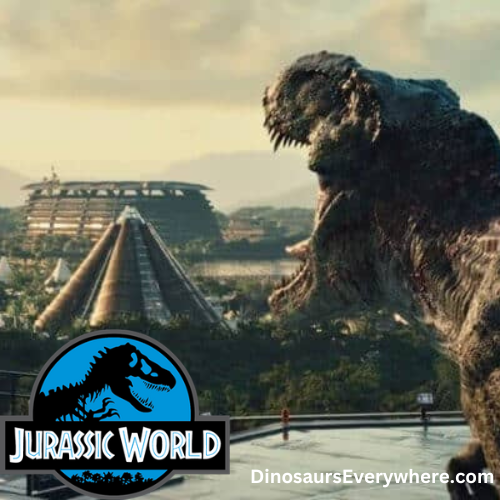


Rexy is back!
The Rex from Jurassic Park is captured and placed in T Rex Kingdom, an enclosure much smaller than her original setting but she’s older now and seems content to be fed on goats and watched by bored guests.
Much like in Jurassic Park, Rexy saves the humans but this time, she was released on purpose – in the hopes she would go after the biggest threat- the Indominus Rex.
Once again after the downfall of a resort on Isla Nublar, Rexy is left to her own devices.
Living wild but this time with many more species on the loose, Rexy has more competition than last time. Before it was Raptors and Dilophosaurs, this time there are Carnotaurs and Baryonyx amongst other things. Even the water isn’t safe since there’s a Mosasaurus in there somewhere!
During the destruction of Isla Nublar by a volcano no less, Rexy was captured by Fallen Kingdom’s bad guys and ended up free on the mainland. During the events of Dominion, she ends up in Biosyn Valley all the way in Northern Italy, nestled in a lush habitat between the Dolomite Mountains. Strangely they just lumped her in with the Giganotosaurus, Therizinosaurus and other huge dinosaurs who all want their own territory in the same region. Maybe they forgot these are animals worth millions of dollars, which after all was the driving force behind Dodgson – the owner of BioSyn.
So it’s…
Jurassic World: Rexy from Jurassic Park
Fallen Kingdom: Rexy again
Dominion: Rexy with a whole new habitat in the BioSyn Valley to dominate and live out the rest of her days.
7. Gallimimus

The Gallimimus was one of faster dinosaur species featured in the Jurassic Park movie. It is known for its long legs, which allow it to run very fast. In the movie, it is shown running alongside the main characters as they try to escape from the herd of dinosaurs. One of the notes Dr Grant makes is how bird-like they are, running like birds and turning quickly to avoid danger.
The Gallimimus was portrayed as a flocking and herding species in the film, living peacefully with other dinosaurs on Isla Nublar. While not a major character, it played an important role in showcasing the diversity of dinosaurs on display at Jurassic Park.
Not only did the Gallimimus scene showcase an amazing advancement of special effects in movies, it also showcased how fast, agile and intimidating even the gentle herbivores could be. Open ground, with little cover, Dr Alan Grant and the kids have to get out of the way of these almost-stampeding dinosaurs and in a turn of events the Tyrannosaurus Rex shows an impressive feat of ambushing the fleeing Gallimimus.
The humans (mostly Dr Alan Grant and Tim) are look on in both terror and awe. The flocking behaviour also confirms one of Grant’s key theories of the time, that birds evolved from a lineage of dinosaurs (widely accepted these days).
What Made the Dinosaurs in Jurassic Park so Good?
With a masterful blend of CGI and practical effects, especially for the time (1993), not to mention a Hollywood favourite director, Stephen Spielberg, the dinosaurs were brought to life by Stan Winston and his people with their movie magic, Jack Horner and his dinosaur expertise and countless other talented people by showing these creatures not as monsters, but as animals.
The characters mention that the dinosaurs have no idea they’ve been brought back to life after countless millennia and Dr Ian Malcolm in particular doesn’t think bringing these animals back is a good idea, you can’t control something like this, especially in a zoo or animal park setting.
The dinosaurs are alive and just behave like dangerous animals would, only we have no idea of what to expect – even to the scientists that created them, they can only observe as the animals grow, adapt and live.
With practical effects for close ups and CGI for long shots (generally), you get glimpses of speed, cunning and little things like the T rex’s eye dilating when she looks into the kid’s car or the window misting up when the raptor snarls at the door when looking for its human prey, all go into making you feel like these are living, breathing animals.
Jurassic Park has captured the imagination of audiences worldwide with its thrilling portrayal of dinosaurs. From the majestic Brachiosaurus to the fearsome Tyrannosaurus Rex, the movie showcases a wide variety of prehistoric creatures.
Dinosaurs in The Lost World
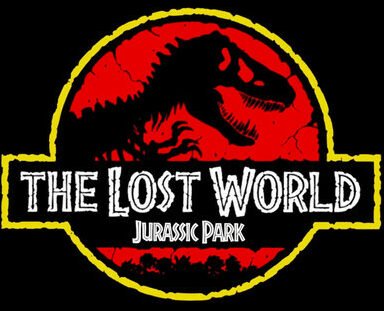
Something has survived…
With more dinosaurs, more action and witty dialogue, this is a solid entry in the Jurassic franchise. Let’s see what dinosaurs were encountered in 1997!
Compsognathus
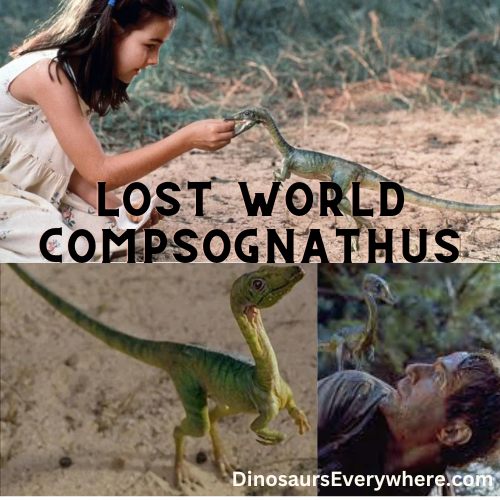
This little fella really grabbed grabbed my attention when I first watched the Lost World. A dinosaur the size of a chicken – and yet it can be just as dangerous as the huge dinosaurs that can eat you, crush you or impale you, if there are enough of them. First seen on the opening beach scene, the “Compys” are shown to be inquisitive and take food from a child who happens to be exploring whilst her parents are having lunch. After eyeing the child up, more and more Compys come out and the little girl is attacked off screen.
Later on, the Compys attack and kill a lost hunter, Dieter Stark, when he becomes disorientated (this is also after he shocks a Compsognathus to make them scared of humans, so it’s a kind of revenge, too).
Did You Know?
In the Jurassic Park novel, John Hammond is killed by a group of Compsognathus after stumbling down a hill not far from his bungalow – after being scared by a Tyrannosaurus Rex roar being played on speakers by his grandchildren. Oops.
The Compsognathus are known by InGen – the creators of Jurassic Park and owned by Hammond – to have a mild toxin in their saliva to cause numbness and a sedative for the victim to relax… as they’re being eaten.
If you haven’t read the novel, I’d recommend giving it a go. Even if you’re not a reader, you can get the audiobook for free by clicking below:
Stegosaurus
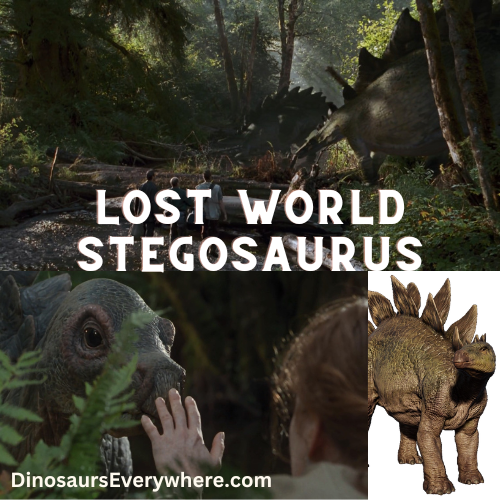
In the original movie, the Triceratops had taken the place of the Stegosaurus, I believe because the Trike was Spielberg’s favourite dinosaur. In the novel, it’s the Stegosaurus that the guests found and investigated what made it ill. In the Lost World, we got to see a dynamic herd of Stegosaurus defending their young.
This made a change from just seeing the carnivores as a threat and really showed how aggressive and dangerous these giant, plated and spiky-tailed creatures could have been!
Pachycephalosaurus

Another example of a dangerous herbivore, the Pachycephalosaurus has always reminded me of the classic African mammals in terms of how dangerous they must have been. These particular dinosaurs likely grazed on ferns, cycads, and other low-lying vegetation prevalent in its habitat. The structure of its teeth suggests an adaptation for grinding plant material – so they’re nothing like the always-hungry, sharp clawed and teethed carnivores – but as shown in the Lost World, they could simply headbutt you through a car door and out the side. We don’t know their temperament whether aggressive or nature or just defending itself, I would stay out of the way of these knuckleheads as much as I would stay away from a hippo or rhino!
We then get to see Parasaurolophus again with the mixed herd the new group of hunters are going after. But the next new Dinosaur species is a well known sauropod…
Apatosaurus

A dinosaur instantly recognisable. Even if people don’t know what it is exactly or confuse it with Brachiosaurus, it’s clearly “Dinosaur.” A cool immersion in this scene is shown when a hunter on a motorbike rides from behind and beneath an Apatosaurus, right between its legs. This cleverly shows the scale of the animal and makes it more believable in the scene.
The Apatosaurus looks like a Brachiosaurus, as they both have the sauropod body plan, a long neck and tail with bulky midsection and huge, tree trunk-sized legs. But an easy way to tell (for me, at least) is the Apatosaurus is more forward in the neck, whereas Brachiosaurus has a more upright neck. The Apatosaurus also appears more slender, with a thinner tail and neck. It’s also missing the pronounced nasal bit on the head, which the Brachiosaurus is known for.
During the mixed herd scene where the hunters – the second group sent by InGen – are rounding up a selection of dinosaur spcecies, we get a glimpse of Gallimimus (or Struthimimus?) and then Parasaurolophus again. Whether this is scientifically accurate or not doesn’t really come into it. As far as the movie goes, a group of extinct creatures from various different time periods and locations have been lumped into a small island and these herbivores need all the help they can get avoiding the huge and smart carnivores!
Later on, we get Compsognathus again but with some foreshadowing as Dieter Stark shocks a Compy with a taser prod device.
Baby Tyrannosaurus – or Juvenile Depending on Age

Back in 1997 when the Lost World was shown at cinemas, this. Was. Awesome.
We got to see fully wild and successfully breeding T rexes and how they may have formed social or family units. It’s not unheard of in reptiles – many Crocodilians care for their young and even the males respond to distress calls.
What I still enjoy about the scenes featuring the juvenile rex is seeing how ungainly it is and the different proportions compared to its parents.
Next up we have more Stegosaurus and then Triceratops – a bit more of a lively Trike than in Jurassic Park! Obviously the group Hammond sent to the island was there only to observe and capture evidence, but as Hammond secretly expected his nephew Peter Ludlow to go there and bring a bunch of Dino’s to the mainland, Nick Van Owen was his backup plan (sabotage!). Releasing the captured Dinosaurs resulted in the hunter’s camp being destroyed.
TWO Tyranosaurus Rexes!
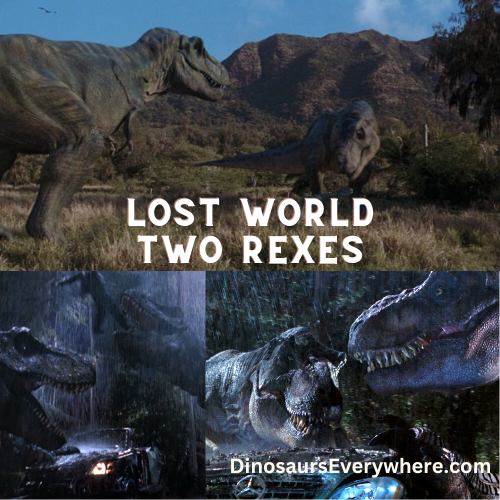
So now we’ve gone from one T rex in Jurassic Park to two adult Tyrannosaurs and their infant. A cool twist when the juvenile rex is in the trailer being treated is the fact that both parents come back to rescue their offspring – and then return with a vengeance to kill or eat their perceived threat. I still think Eddie Carr’s death is one of the most brutal of the original franchise. It’s up there with the death of Zara Young in Jurassic World.
We get to see how dangerous Compies can really be when Dieter Stark gets lost and disorientated – another “bad guy death” in the series.
Tyrannosaurus Rex (male/buck, I think) returns to hunt the hunter party by following the blood scent on Dr Sarah Harding’s top. You would have thought a field scientist like Harding would have thought to get rid of the blood-soaked top after she explained earlier on how good the Dinosaur’s sense of smell is.
A New Breed of Velociraptor

We’re near the final act of the movie now and we finally get to see what the Raptors have been up to…
New colours, same viscous tendencies. Having been breeding unchecked in the wild, competing with all the other carnivores and each other, the Velociraptors in the Lost World are savage. For the first time we also see a human kill a Velociraptor – with gymnastics. Kelly manages to use momentum from swinging over a pole and kicks a Raptor who is about to kill Dr Malcolm and Dr Harding, sending it through a window and plummeting to its death as it is impaled on something on the ground. The designs of the Raptors are striking, and seeing them hunt in both long grass and an urban environment was awesome. Even if you compare this scene to the latest Jurassic World: Dominion scene in Malta with the Atrociraptors, the atmosphere of the abandoned worker village in the dark and more use of animatronics over CGI makes the Raptors in the Lost World that much more believable – despite the two moves being decades apart.
These raptors have survived since humans abandoned Isla Sorna and if you thought the original Raptors were dangerous, try a wild pack of them that have competed with all the other dinosaurs for dominance, forming their very own territory around and in the Village Compound. Don’t go into the long grass!
Moving on to What Feels Like a Tacked-on Finale…
Then we’re back to the male Rex as Roland managed to take him down for Ludlow to transport to San Diego; he has clearly learned nothing from the first island or the very events he was involved in!
After the climax of a rampaging T rex running around a city, Dr Sarah Harding and Dr Ian Malcolm manage to send the male and juvenile rexes back to Isla Sorna and we’re treated to an epilogue of sorts.
John Hammond, now being a naturalist and wanting to protect the now-wild and known dinosaurs has a little speech over what always reminded me a classic dinosaur mural, only real looking and moving. It’s a very short scene but with a lot of dinosaur eye candy thrown in – especially for 1997!
The Lost World Epilogue Species
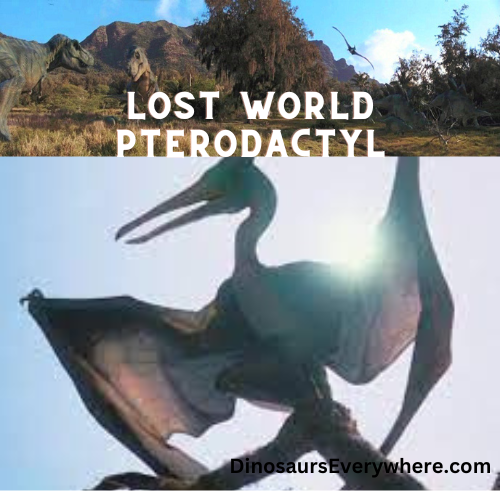
We’re back with the reunited Tyrannosaurus Rex trio, what looks like the same herd of Stegosaurus strutting dangerously close to the aforementioned apex and highly territorial and protective predators and our first flying reptile!
Not a dinosaur, but often associated with dinosaurs because of when they lived and how they looked, we see the first on screen Jurassic Park Pterodactyl coming into land with other Pterodactyls flying in the background.
What Made the Lost World Such a Good Sequel
For me, it wasn’t just the added dinosaurs and more action, or even the return of Dr Ian Malcolm, though that was a massive part of it. But what made it a great sequel and amazing Dinosaur movie were the world building aspects of Jurassic Park.
The new island part of it still feels like a bit of a cop out. But in context of the author of the Jurassic Park novel, Michael Chrichton, not planning on a sequel and Stephen Spielberg persuading him to write a novel to base a movie sequel on, it was convenient. It also allowed for a blank slate of sorts. They could cram in more species and locations without it impacting the original.
What makes it re-watchable for me is the writing, dialogue and interactions between the humans. It doesn’t feel like one of those monster movies where you want to skip the boring people bits. The “bad guys,” probably with the exception of Peter Ludlow, aren’t entirely bad, but well fleshed out. In fact, they choose to rescue the main characters despite having their own camp destroyed by said main characters. Near the end, Roland Tembo shows regret and sorrow at his men dying and turns down a job at InGen, calling it a Company of Death. This went over my head as a kid but now I think it really shows a well developed character with an arc, which you don’t normally see in this kind of movie with this many characters.
Then there’s the Dinosaurs, with their own ecosystem on Isla Sorna, and we get to see how they’re surviving and coexisting in a carefully balanced system. The carnivores have territories in the interior and the herbivores mostly the outside of the island.
“Life, uh… finds a way”
I remember thinking as a kid seeing the trailers and promotions of the Lost World, how did they get past the The Lysine Contingency, a safeguard Dr Henry Wu placed in the Dinosaurs to prevent them living if they escape or get to the mainland. The idea in the first movie (and novel, I think) was that the animals could not produce the amino acid Lysine, so would slip into a coma and die if not fed specific food from Jurassic Park.
The tagline of the Lost World was “Something has Survived” and it isn’t too long before we get the explanation from Dr Sarah Harding: The herbivores eat Lysine-rich plants and the carnivores eat the herbivores so they get a concentrated amount of the amino acid themselves. It just sounds to me like Dr Wu didn’t do his job very well, but it does fit into Dr Malcolm’s proclamation of life breaking through barriers and finding ways to survive and thrive.
Dinosaurs in Jurassic Park III
This time it’s not just a walk in the park!
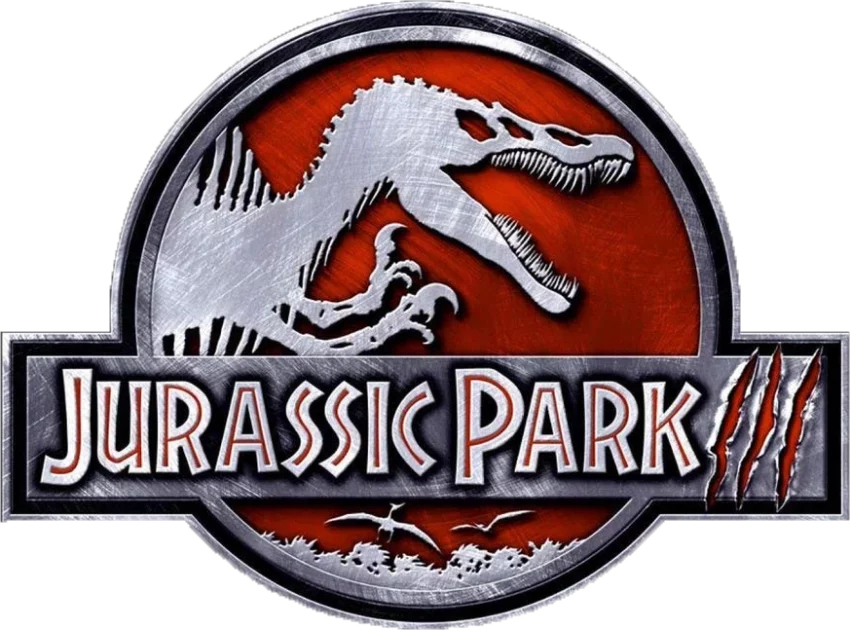
Three films in and we see the antagonist has gone from the mighty T rex to the “bigger” Spinosaurus.
There’s a lot of controversy around this movie, and I think for good reason. I still love the movie, but it’s definitely one of the weaker ones in the franchise. Scripting issues, a decision to kill off a T rex (not one we know, but a T rex nonetheless) and that dream sequence on the plane…
Jurassic Park 3 is the first Jurassic movie to not have Stephen Spielberg directing and also to not be based on a novel by Michael Chrichton. Instead, it was directed by Joe Johnston.
Our first creature isn’t actually seen on screen in this Jurassic movie, but insinuated. The Dino-Soar tour operators on the boat are the first victims, but we don’t see what kills them. I always assumed they just hit some rocks but there are plenty of theories about it being the Spinosaurus, Raptors, even Pteranodons (which aren’t released until later in the movie but we do see a variant of this in the epilogue of the Lost World, as we saw above).
What this comes down to is what comes up a few times in this movie – script and production issues.
Once Eric, the main kid protagonist and his step dad are stranded on the island, we move to Dr Alan Grant and Dr Ellie Sattler – an aspect that divided fans as they are now split up, romantically and professionally. Dr Sattler has moved on, is married and has a child.
Technically the first visual dinosaur we see is Dr Sattler’s pet parrot, but that’s probably being pedantic…
Back to Site B – Isla Sorna
Later on when Eric’s parents trick Dr Alan Grant and get him back to Isla Sorna, with his colleague Billy, we see a mixed herd on their flyover before Dr Grant becomes aware that something isn’t right with his hosts. There is the dream with the Velociraptor on the plane but since the Raptors are a staple and it isn’t actual dinosaur from the island, we’ll get to them properly later – it’s worth it!
In the mixed herd seen below, you can see mostly what we’ve seen in the previous two movies, with the exception, I think, of Corythosaurus seen in the first image. The ones we’ve seen already are the likes of Brachiosaurus and Stegosaurus.
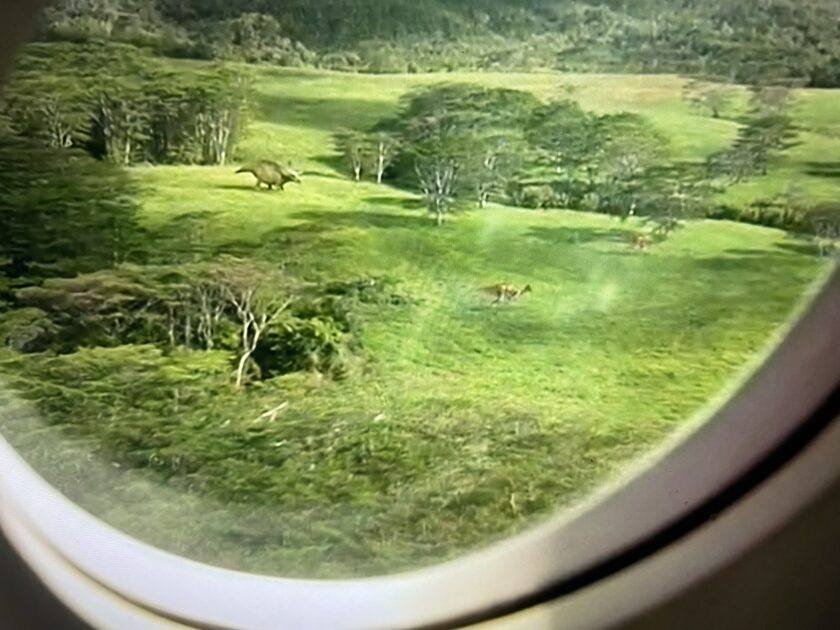
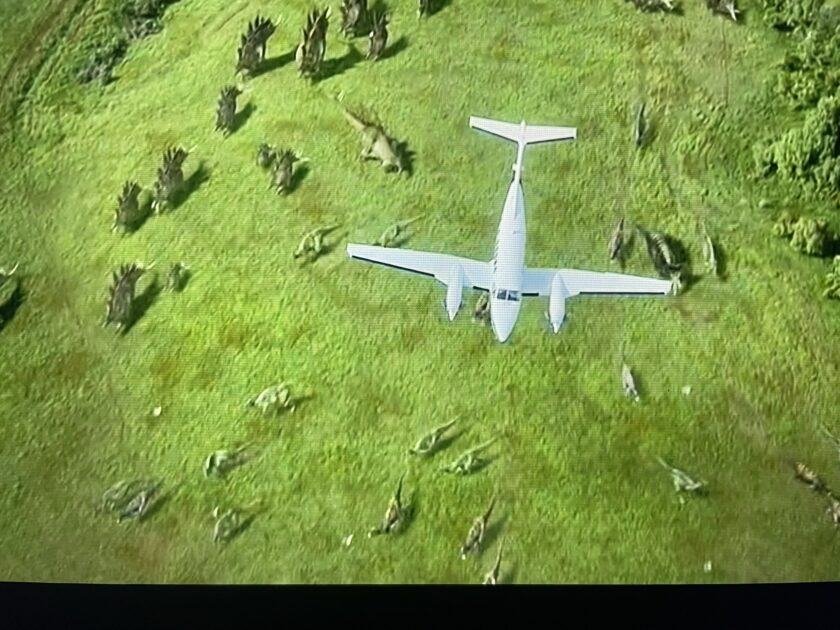

Eric!
Now, unlike the previous two JP movies, we’re treated to the antagonist almost as soon as they land.
This is most likely due to the fact taking the one expert under false pretenses and knocking him out as they’re about to land (Cooper hits Dr Alan Grant when he asks why they’re landing) and they start shouting through a loudspeaker…
Spinosaurus

It was rumoured to be a Baryonyx before filming began, which we do get to see in later movies. The Spino in JP3 really divided fans, mostly because it killed the beloved T rex and even featured on the JP3 logo.
It wasn’t just a bigger dinosaur, this particular one was extremely aggressive and more of a “monster” than all the previous JP carnivorous species.
JP3 Raptors
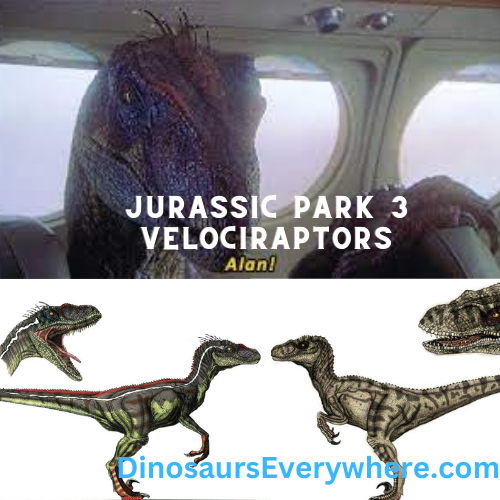
It was around this time that dinosaurs sporting feathers was gaining traction in the public eye, which fits perfectly with the theme with Dr Alan Grant during the original movie: birds are dinosaurs.
These packs are shown to be just as deadly, and more “evolved” (according the taglines at the time) with more definite sexual dimorphism between the males and females and what looks like not just hunting packs, but actual social groups.
(Credit to Deviant Art artist YankeeTrex for the amazing JP3 Raptor art)
Corythosaurus

This shows up again, but blink and you miss it.
I’ve added it anyway as it’s a nice addition to the variety of species shown on Isla Sorna, especially in a mixed herd. It isn’t known if these kinds of herds existed, but being huge, cloned creatures crammed on a small island full of other cloned creatures trying to eat them, it makes perfect sense that they would stick with the likes of Brachiosaurus and Stegosaurus…
Credit to Steam Workshop artist Patrik Cauan and American Museum of Natural History
Once the survivors get through the herd and lose another member – who was used as bait, no less, Dr Grant is rescued by the kid they’re looking for, Eric, and we get another glimpse of one of my favourites, the Compsognathus.
The parents and Billy have an Ankylosaurus walking by in their neck of the woods but this is a fleeting glimpse. We see much more of these weaponised dinosaurs in the first of the next trilogy.
Then the two groups reunite via the silly gag with the phone ringing from within the Spinosaurus (he ate the guy who borrowed it).
Pteranodons

Not actually a dinosaur, but just as worthy and deadly an addition to the Jurassic Park collection of creatures, this flying reptile is first seen up close and personal when the humans accidentally stumble into an aviary…
This scene to my mind has some of the best practical effects of the original trilogy…
We also discover there’s a reason the raptors are following the humans, other than just to snack on – Billy stole a couple of their eggs! It isn’t unheard of for reptiles to care for their young. In fact, with some crocodilians, other parents including males, will protect the hatchlings when they give a distressed call.
Then we see the Ankylosaurus again, a pair this time as the survivors float down the river in an abandoned boat. This is again fleeting, as we are treated to more Brachiosaurus, Parasaurolophus and Stegosaurus.
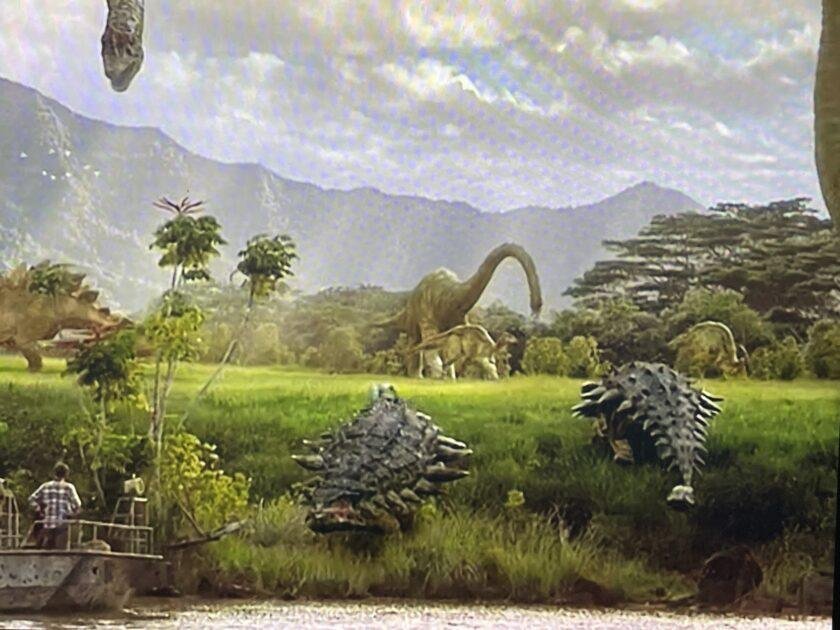
Ceratosaurus

This was one hell of a cameo when I first saw Jurassic Park 3. It was a continuation of the phone in poo gag, but what was cool was more on the theme Eric referred to earlier when he rescued Dr Grant – certain smells scare off or attract certain dinosaur species. And in this case, it was more wary of the Spinosaurus droppings than the desire to hunt and kill the humans.
It seemed more curious than monster-like, despite its appearance!
The Spinosaurus then returns, showcasing its ability to traverse water as well as land, the survivors have to fend it off without drowning. The last dinosaur species we see before they finally escape is the Velociraptors again, still wanting their eggs back.
Once rescued, Dr Grant once again sees something flying alongside the helicopter, only this time its the Pteranodons from earlier, now escaped from their giant bird cage. These aren’t really explained between Jurassic Park 3 and Jurassic World, but I assume they were captured or killed as the new company, Masrani, took control of the islands and captured escaped dinosaurs as well as cloning new ones.
